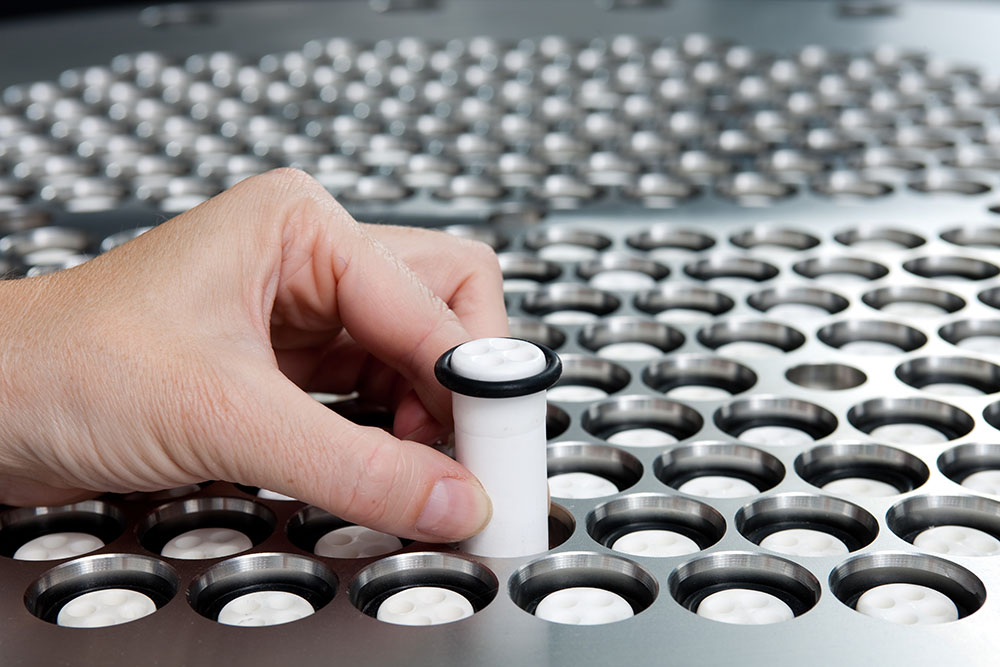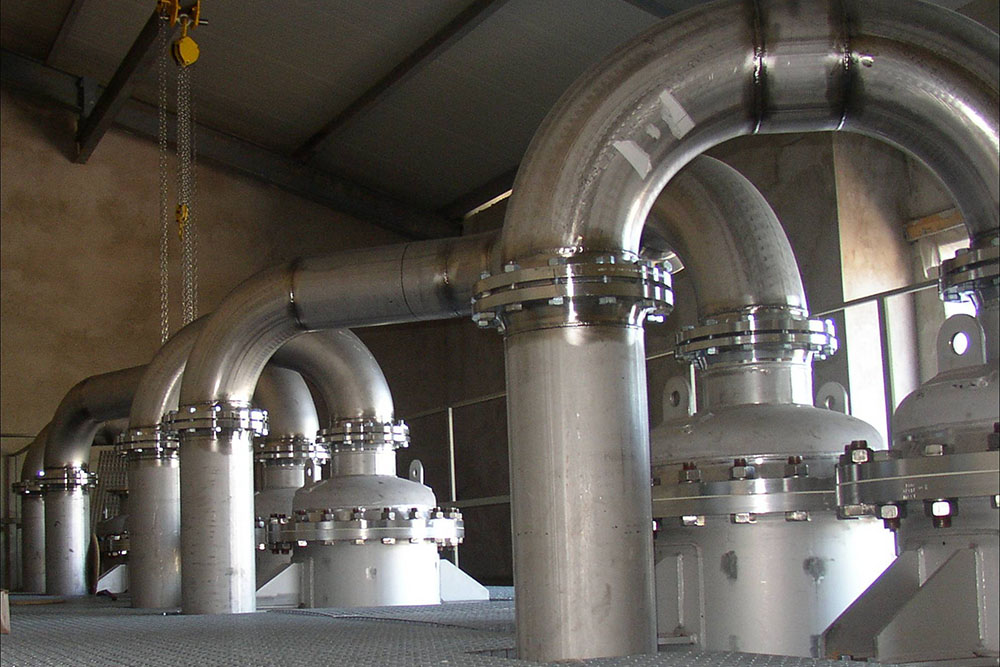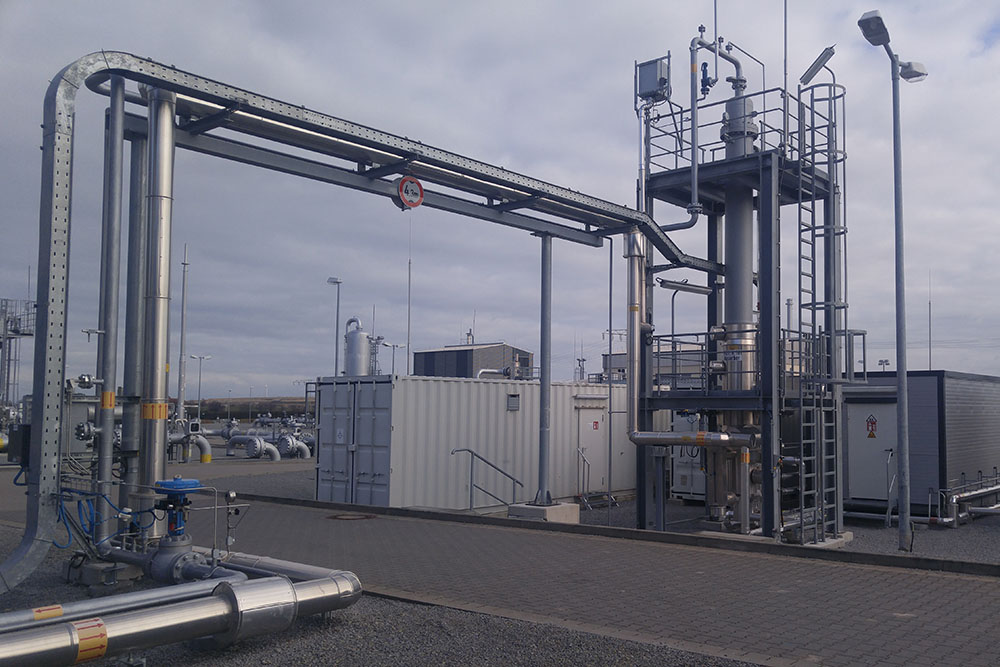Author: Hilde-Josephine Post | Translation: Stephanie Anderseck
How zeolite membranes energy-efficiently dewater organic solvents
High economic and environmental benefits arise when zeolite membranes are used to dewater organic material streams. Researchers at the Fraunhofer Institute for Ceramic Technologies and Systems IKTS have tested and validated this in pilot trials for indirect natural gas drying and alcohol recirculation. Many plant operators can now benefit from this, whether from the natural gas, pharmaceutical, chemical or food industries.
Zeolite type A membranes are basically very hydrophilic and thus predestined for the dewatering of organic solvents. Zeolites are framework silicates that have a specific spatial structure with defined pores. "The challenge," explains Jan-Thomas Kühnert, group leader Membrane Patterns at IKTS, "was to optimize the membrane for the application so that only water penetrates through it and is separated as permeate. We were successful in realizing this." The size of the pores can be determined by the choice of zeolite type. To dehydrate, the IKTS researchers therefore prefer the zeolite NaA, because it forms pores with a diameter of 0.41 nm due to the sodium ion. Only the water molecule with a kinetic diameter of around 0.27 nm can now penetrate here. Other substances, such as ethanol with a diameter of around 0.45 nm, are excluded. Thus, the zeolite A membrane represents a kind of "molecular sieve" that is highly capable of dewatering.
The sieve currently consists of a ceramic carrier tube with four channels. A zeolite membrane layer lies on the inside of each channel. The fluid to be separated is now pumped through the channels at around 120 °C. The zeolite attracts the fluid due to its physical property, hydrophilicity. It settles in the sieve. As a result of the negative pressure of about 20 mbar on the outside of the ceramic tube, the water vaporizes in free permeation through the carrier and is discharged on the outside. This is a continuous pervaporation process intrinsic to the membrane. Due to this specific membrane structure and continuous operation, zeolite membranes are predestined for scalable, modular plant design. This ensures a high degree of flexibility, both when plants are retrofitted and when new plants are built.
Operating cost savings of 30 % and CO2 emission reductions of 80 % with indirect natural gas drying using a zeolite membrane
This zeolite NaA membrane process is used wherever organic solvents have to be reliably dried, i.e. dewatered. The experts at IKTS, together with DBI Gas- und Umwelttechnik GmbH, have already demonstrated the enormous advantages that this process can bring in the indirect drying of natural gas in a pilot plant in Stassfurt with a membrane area of 20 m². Natural gas is stored in underground reservoirs. When the gas is transported under pressure into the storage facility and then extracted again, it comes to the earth's surface moistened and cannot be fed into the natural gas distribution network in this state. This is because water condensation in the pipeline can clog valves.
Triethylene glycol (TEG) has been used as a drying agent here for many years. However, there are some weak points in the process of regenerating the TEG. TEG is an organic substance. Until now, this has been dried by vacuum distillation at 170 °C to 200 °C. However, organics and high temperatures do not go together. As a result, TEG decomposes and has to be renewed regularly. It also produces a vapor gas that has to be burned, which means CO2 emissions and additional energy consumption. Another disadvantage of the previous TEG drying method is that the system must be permanently heated in standby mode to function on demand. This also results in significant thermal energy losses and CO2 emissions. "We asked ourselves," says Kühnert, "can TEG be dried in other ways?" The clear answer from IKTS: yes. With the zeolite NaA membrane process, the above-mentioned deficiencies could be eliminated, and the TEG regeneration process implemented in a more economical, energy-efficient and environmentally friendly way.
This is because the plant now requires significantly lower temperatures. Instead of the 170 °C to 200 °C under vacuum distillation, 120 °C is now sufficient. The advantages: the TEG no longer decomposes as quickly. Furthermore, there are no residual materials such as vapor gas that have to be burned, releasing CO2 emissions. "The decisive advantage, however," emphasizes group manager Kühnert, "is that the TEG drying plant can now be started up quickly and flexibly and no longer waits in preheated standby mode, as was the case with vacuum distillation. DBI Gas- und Umwelttechnik GmbH has thus been able to identify 30 % lower operating costs and 80 % less CO2 emissions." Compared to plants with polymer membranes, the investment costs are somewhat higher at 10 %, but this is quickly compensated for over the course of the operating time. In addition, compared to polymer membranes, ceramic-supported zeolite NaA membranes can be used at higher temperatures and last longer. "Ultimately, you always have to look at the performance of the overall concept," explains Kühnert.
What benefits zeolite membrane plants bring to indirect natural gas drying!
- 30 % operating cost savings
- High plant flexibility, fast start-up, no preheated stand-by mode
- No vapor gas combustion necessary
- Lower process temperature than with vacuum distillation
- TEG decomposes much slower
- Less emission output
- High transferability to other applications
Economical, high-grade dewatering and recirculation of alcohols
Another application in which the zeolite NaA membrane process shows its advantages is the recirculation of alcohols. For example, IKTS has equipped a pilot plant in Chile in which a valuable substance is extracted on the basis of an alcoholic solution. Kühnert reports, "The challenge here was to remove the water from the ethanol during the ongoing process so that the alcohol can be used again and again within a closed-loop system." This brings economic advantages. After all, the manufacture of pharmaceutical products is subject to particularly stringent purity and quality assurance requirements. If a company introduces new batches of ethanol, these have to undergo certain certification processes. This is time-consuming and expensive. The plant operator can avoid this by placing a zeolite NaA membrane plant within the process cycle. This allows the ethanol to be used for a long time before a new batch has to be introduced. "So, at this point, a membrane like this helps conserve resources, close the loop and save costs," Kühnert says. The plant has been in place for four years and has proven its worth.
Other pilot plants in Lithuania and Ukraine focused on the dehydration of bioethanol. Here, distillation reached its limits at 96 percent alcohol by mass. "Using our zeolite membrane plant, we were able to break the azeotrope and achieved a purity of 99.7 percent alcohol by mass," reports the group leader. Looking to the future, Kühnert reveals, "We'll soon be applying this special dewatering process we developed here to the drying of hydrogen as well."
Further information:
Stay informed: You are welcome to subscribe to our newsletter, read our other blog articles and follow us on LinkedIn, Instagram and YouTube.


